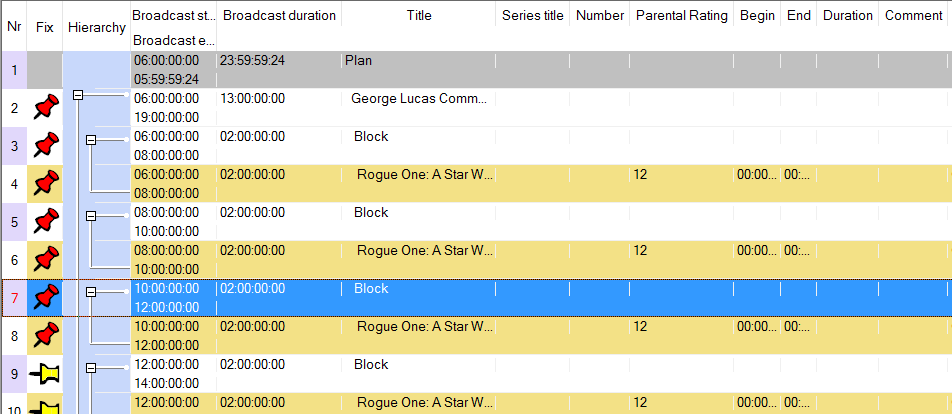1.1 Basic Terms of the Planner
The following chapter will explain the basic terms of the Planner:
Scheduling Stages
Basically a plan or schedule is created by the successive scheduling of individual versions until the plan represents a cohesive progression of events without overlappings or remaining times. On the creation of a plan it gets ever more detailed. There are three operational steps or stages that succeed each other:
| Stage | Activities | Results |
|---|---|---|
1. Template Scheduling (Scheme) |
| Reusable slot template |
2. Program plan (Programmer) |
| Program plan with events for a certain period and channel |
3. Broadcast plan (Planner) |
| Frame-precise and complete broadcast plan, creation of a playlist, generating reports |
Plan
A plan (program plan or broadcast plan) is just a section of the overall schedule for a channel over the time. This section is also characterized by choice of time (date) and channel. This can be a month for movie channels or a week/several days. Thus a plan is a coherent section between a start and end date. In abstract words the program plan (and broadcast plan) represents the subset of the overall schedule.
Schedule-Able Elements in the Planner
The following list specifies all elements of the Planner that can be scheduled and/or are relevant for broadcasting:
- Versions of programs or series: These elements can only be scheduled in the Programmer but are taken over into the Planner for further editing and to resolve the remaining times. They can be opened and edited in the Planner.
- Trailer versions
- Design elements and signations
- Commercials and commercial versions
- Secondary events, Layouts (e.g. Back-Agains, Squeeze-Backs, Upper-Third-Next)
Commercials
Commercials and commercial versions are scheduled into ad breaks (placeholder elements reserved for commercials) in the Planner. Commercials can either be scheduled manually or automatically after importing them. Commercials are created in the ContentExplorer.
Signation
A signation is a promotion element which is scheduled within the Planner to resolve the remaining time in between of program events. It serves to design the channel by making it recognizable (graphical animations etc.).
Jingle
A Jingle is a promotion element which is scheduled in the Planner to resolve the remaining time in between of program elements. Jingles also serve to design a channel (graphical animations etc.), but they are shorter than signations.
Boards
A board is a promotion element which can be scheduled in the Planner to resolve the remaining time in between of program elements. Boards announce a program (either as count-down boards or in stationary way).
Commercial Separators
A commercial separator is a design element with a fix length which is broadcast before and after an ad break (a commercial block) to make the transition from the program to commercials more fluent. Commercial separators have a fix length and can be scheduled automatically with a wizard.
Secondary Events
Secondary Events are events that serve to design the channel additionally during the running program. They are broadcast in form of crawls, inserts or else and give information on the current or subsequent program. Secondary events represent an own hierarchy level; they can be directly subordinate to the plan or to the respective events. Currently the Planner gives the option to schedule the following secondary events to respective main events:
- Back-again: Here the title (including further titles or texts) is blended into the current program after a commercial break.
- Squeeze-back: At a certain time as for example at the end credits of an event graphical elements are blended in while minimizing the picture to show a trailer or other element.
- Upper-third-next: Here the title of the subsequent program is blended in, mostly in the last third of the current program.
- News ticker: A news ticker is a layout that blends in the current news as a running text at the bottom of the program.
- Secondary ad break: This is a ad break type, which is commercial quota relevant and can be scheduled in the Programmer, Scheme and Planner. This ad break does not need additional broadcasting time and does not interrupt the program. It belongs - like all secondary event - to a main event.
Frame-Precise Data
The scheduling in the Planner is carried out in frames. Thus every start date, duration and end time is stored in frames; according to the European PAL-norm 25 frames take 1 second (1 frame has 25 images, thus 1 frame is 0,04 seconds). For displaying these data in the plan they are converted in the following formats that are required for certain purposes:
- Date specification: 04.05.2011
Announcement of an event at a certain day - Specification to the minute: 04.05.2011 16:25
Indication of the start time of an event. Here it is mostly rounded up or down to 5 minutes. This time represents the so-called SI-time (SI=Service information) for a time specification that is communicated externally. - Specification to the second: 04.05.2011 16:25:12
Specification of the time for a commercial break - Specification to the frame: 04.05.2011 16:25:12:21
for start and end times in the dialogs of slots and events in the Programmer.
